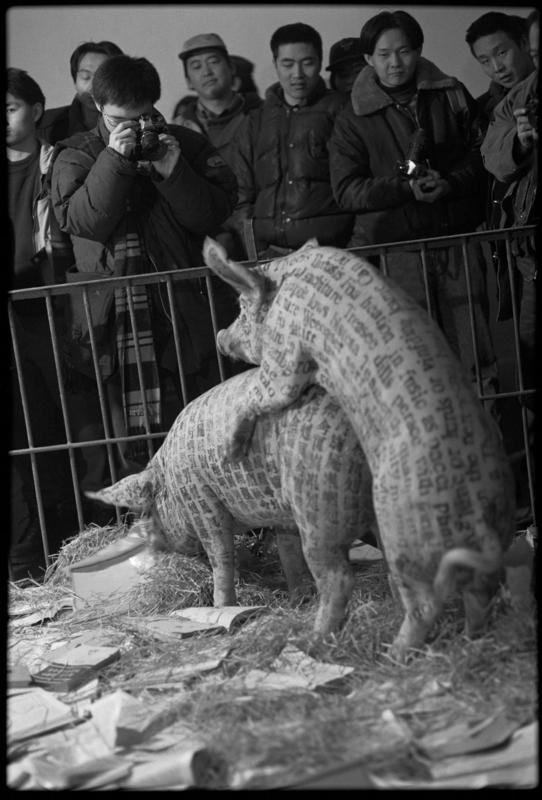More about A Case Study of Transference

Contributor
A Case Study of Transference by Xu Bing might be the most disturbing thing you see today…unless you’re a farmer.
A Case Study of Transference is “a video documentation of a 1994 performance in which two pigs, one imprinted with nonsensical English words and one stamped with fanciful Chinese characters, copulate before a live audience.” The pros of this piece are that 1) it makes for a very thought-provoking work and 2) no one can ever say that Xu Bing lacked originality. Compassion for animals? Maybe. But originality? Never.
The meaning of the work is heavily reliant on the nationality/gender pairings of the pigs. The male pig is printed with English nonsense, while the female pig is printed with Chinese nonsense. The piece “is a satirical take on the collision of East and West.” Literally, by collision they mean sexual intercourse but metaphorically, collision means the sharing of ideas, languages, and cultures. Xu Bing came of age during the Cultural Revolution in China, a time when China was completely closed off to the outside world. Xu spent a significant portion of this time working on a farm in the countryside, hence the pigs. Then he worked for China’s propaganda brigade, making big-character posters, hence the calligraphy on the pigs. And lastly he moved to New York after his work in China began to be censored, hence the connecting of the East and the West via calligraffitied pigs.
This piece was legendary for sure, but not everyone was very excited about it. When the Guggenheim decided to put it in their exhibition titled, Art and China after 1989: Theater of the World along with two other pieces that included the use (or abuse) of animals, PETA flipped. They put together a petition in favor of cruelty free art that got over 820,000 signatures. But this is not what made the Guggenheim decide to pull these artworks from the exhibit. It was threats of violence that put them over the edge. In a statement about the decision the Guggenheim said, “Although these works have been exhibited in museums in Asia, Europe, and the United States, the Guggenheim regrets that explicit and repeated threats of violence have made our decision necessary,” and “as an arts institution committed to presenting a multiplicity of voices, we are dismayed that we must withhold works of art. Freedom of expression has always been and will remain a paramount value of the Guggenheim.” Instead of exhibiting the piece, they displayed a blank TV screen, because DRAMA.
Sources
- "Guggenheim Acquiring Controversial Xu Bing Work Pulled From Recent ‘China’ Show -." ARTnews. N.p., 2017. Web. 27 Apr. 2018.
- "Guggenheim Receives Xu Bing Work, Targeted By Animal Rights Activists, From Anonymous Donor." Artforum.com. N.p., 2018. Web. 27 Apr. 2018.
- Intellectual By Nature, Poet At Heart: Xu Bing | Brilliant Ideas Ep. 15. United States: Bloomberg, 2015. video.
- Pollack, Barbara. "Controversial Xu Bing Work Enters The Guggenheim Museum’S Collection." Nytimes.com. N.p., 2018. Web. 25 Apr. 2018.
- Sutton, Benjamin. "Guggenheim Accused Of Supporting Animal Cruelty In New Exhibition." Hyperallergic. N.p., 2017. Web. 27 Apr. 2018.
- Sutton, Benjamin. "Guggenheim Pulls Three Works From Upcoming Show After Outcry Over Animal Abuse [UPDATED]." Hyperallergic. N.p., 2017. Web. 24 Apr. 2018.











